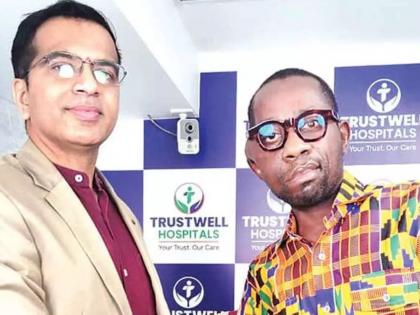43-Year-Old Nigerian Doctor Undergoes Pioneering Facial Reanimation Surgery in Bengaluru; First-of-Its-Kind in India
By Anubha Jain | Updated: September 24, 2024 17:30 IST2024-09-24T17:29:44+5:302024-09-24T17:30:54+5:30
A 43-year-old optometrist Gabriel Pascal from Nigeria since his childhood could not express his emotions or control the movement ...

43-Year-Old Nigerian Doctor Undergoes Pioneering Facial Reanimation Surgery in Bengaluru; First-of-Its-Kind in India
A 43-year-old optometrist Gabriel Pascal from Nigeria since his childhood could not express his emotions or control the movement of his eyelids that deny closing and blinking repeatedly. With time Gabriel's symptoms got worse. Pascal’s tumour was initially removed by a surgical oncology team at another hospital, and he was later referred to Trustwell Hospitals for facial nerve reconstruction. He was diagnosed with facial nerve paralysis. In this condition, a patient can’t smile, or struggle to speak, and also causes difficulty in closing eyes.On September 4th, Dr. Vishwas Vijayadev, a facial cosmetic and reconstructive surgeon along with his team members Dr. Anand Subhash, Dr. Stuti Mahajan, and Dr. Sravya Kakollu performed an 11-hour long facial reanimation surgery on Gabriel. Doctors said the cause of this condition was his bony tumour.
Facial reanimation is a complex surgery and through the procedure, the doctors give life back to the facial nerves and muscles mainly related to the mouth by joining new donor nerves from other areas of the body to the faulty facial nerve making the face work again. In Gabriel’s case, doctors did first of its kind surgery, a double nerve transfer where his leg nerve transferred to his face and further connected it to the functional facial nerve on the unaffected side. An another nerve for chewing was rerouted to activate the paralyzed facial nerve, the doctors’ team added. The surgery was done microscopically through a nerve monitoring system and there was constant monitoring of Gabriel’s condition.
Dr. Vishwas said that in this surgery the situation was more challenging as we couldn’t store the nerves as they would die away. The process required handling it in a highly competent manner, accurately with specialized techniques to reconnect the nerves across the face without causing any damage. The surgery also involved advanced techniques for eye closure, a key improvement over conventional methods used in India. Doctors informed that after surgery, the patient is fine and able to express a bit. His stitches were also removed. He is expected to regain full facial function in the coming months. Dr. Vishwas said that Gabriel came to our hospital after searching for treatment across the world. Such cases are not treating in India due to lack of adoption and availability of technology.